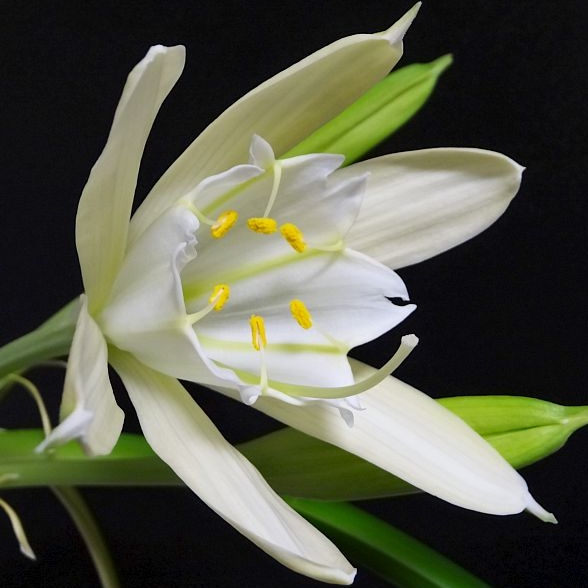Germinating the seeds
Your seeds should be planted promptly when received.
You may plant them all in a single container, since they will be transplanted after a few months. Use a pot about 3 inches (8 cm) tall, and wide enough so each seed is at least 1 inch (2.5 cm) apart. Fill the pot with a mix of equal parts of small perlite and vermiculite. The particle size for both should be around 2-5 mm / ⅛-¼inch), so avoid buying the "coarse" grade. If necessary, screen them to remove any large pieces and dust-like particles. If you only have larger grades of them, you may crush the perlite and crumble the vermiculite, and then screen them. The seed should be planted so the papery "wing" of the seed is up. Push the tip of the seed down into the surface so the seed is just barely covered. It's ok if the wing breaks off, but if you can't tell which end of the seed goes down, plant it sideways. Add water until the mix is evenly moist. If your tap water is very "hard" (high in minerals) you might need to use bottled water or rain water. The first few months, the pot should be covered with a clear bag to maintain moisture around the seedlings, since they have small roots. Punch 3-4 holes in the bag to allow some fresh air in. Ensure that the seeds always stay moist. You may need to drip water around the seeds every few days. Until they sprout, try to keep them
between about 68-79 degrees F (20-26°C) during the day. A little cooler at night is ok. Avoid
letting them get above 80° F (27°C). I recommend placing a
minimum/maximum thermometer Keep them in bright light out of direct sun. A bright LED bulb placed 3-4 inches (8-10 cm) away provides the right amount of light (See: "Growing indoors with LED lights"). The seeds will first grow a root, followed by a leaf later on. They tend to sprout at different times, with most of them sprouting between 5 and 9 weeks, but occasionally longer. After they sprout, continue giving bright light, with no direct sun the first 6 months unless it's weak. Fertilizing -- I recommend feeding the young sprouts once a week with a small amount of dilute liquid fertilizer at 1/8th strength. Hydroponic fertilizer is ideal for young seedlings, since it is easily absorbed and contains all essential nutrients. Give the first feeding when the sprouts are a week old. Once a month, flush the pots to remover fertilizer buildup. After a few months, when they are about 4 inches (10 cm) tall, you may dig them up and repot. You can plant them in individual containers about 4 inches (10 cm) tall. Cover them with a bag as before for 1 more month, then acclimate them to lower humidity using this method. Soil -- Use a loose, well-draining medium. For plants under 1 year old, a typical mix is 1 part potting soil to 1 part perlite (same size as before or slightly bigger). An alternate mix is 2 parts coco fiber to 3 parts perlite, with some granular fertilizer added. Don't add lime to the mix. For plants over 1 year old, use a chunkier, fast-draining mix. A typical mix is equal parts of small-grade orchid bark and long-fiber New Zealand sphagnum moss. You may continue using liquid fertilizer weekly, flushing periodically with water. Watering - The plants like to have their roots kept moist, so aim to keep the soil evenly moistened, but not constantly saturated. Growing onward.. Climate -- It grows well between 65 and 85 degrees F (18-30°C) during the day. Night temperatures should be above 55° F (13°C). Over about 40-50% humidity is best. The plant is generally evergreen. Lighting -- It enjoys bright, filtered light. Some morning sun can work, but it needs shading from strong afternoon sun. It can flower in about a 1-2 gallon (4-8 liter) pot. Avoid disturbing the roots when it nears flowering size, since that can delay flowering. Its normal for the plant to grow sideways, like it would on trees in the wild. If the pot tries to tip over, you may need to put a weight on side. If you want them to grow vertically, you can try training them upright when they're young. If you have questions, feel free to contact me. - Jeff Strange Wonderful Things
|
|||||||||


